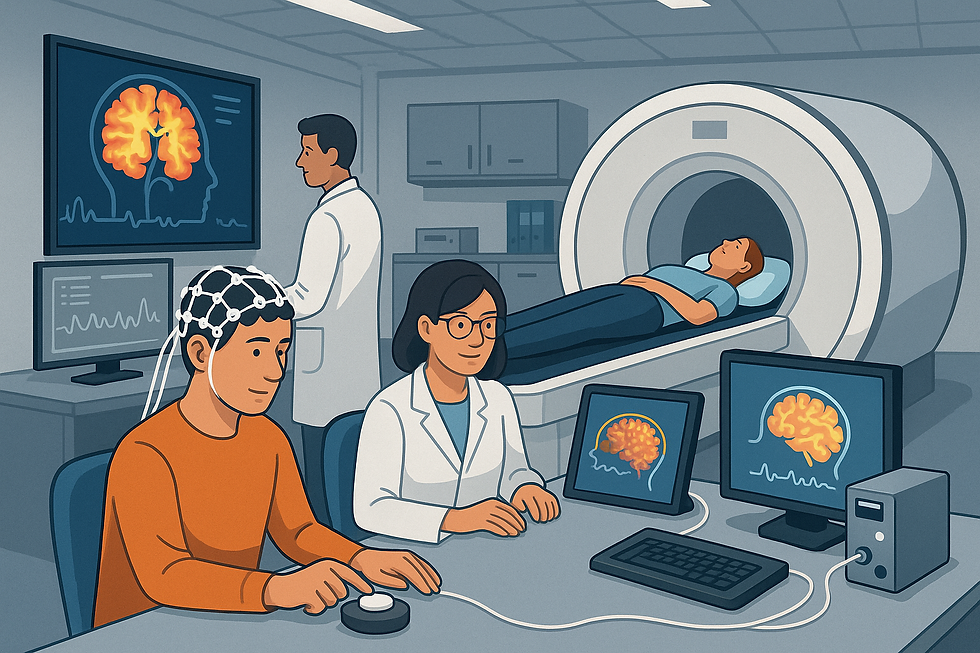WHAT IS BEHAVIORAL NEUROSCIENCE?
- Marcela Emilia Silva do Valle Pereira Ma Emilia
- Jul 15
- 4 min read

🧠 What is Behavioral Neuroscience?
Have you ever wondered why we make certain decisions even when we know they aren’t the best ones? Or why we repeat habits, even when we're aware of their consequences? The answer may lie in the intersection between the brain and behavior — in other words, in behavioral neuroscience.
This area of science has gained prominence in recent decades by bringing together the best of two worlds: the biological functioning of the brain and the objective study of human behavior. What’s most interesting is that it offers practical applications that directly impact our daily lives — from education to justice, from mental health to the corporate world.
In this post, we’ll explore in depth what behavioral neuroscience is, how it works, and why it’s essential for understanding human beings in the 21st century.
🔬 What is behavioral neuroscience?

Behavioral neuroscience is a subfield of neuroscience that investigates how brain processes influence behavior. It is based on the idea that all human behavior — from simple decisions to complex social interactions — has a neurobiological basis that can be studied empirically.
According to Robert Clark (2019), behavioral neuroscience is grounded in biological psychology, physiological psychology, and psychobiology. As all of these disciplines are rooted in animal biology, they could be unified in a single study that encompasses motivation, sensory systems, perception, sleep, emotion, learning, and memory.
This approach seeks to understand which brain structures are involved in functions such as decision-making, emotional regulation, motivation, empathy, self-control, memory, and learning. It differs from cognitive neuroscience by focusing more directly on observable behavior, often integrating insights from experimental and behavioral psychology.
🧪 How does it work in practice?

Behavioral neuroscience combines experiments with brain measurements to investigate how we think and act. The most common methods include:
Functional magnetic resonance imaging (fMRI): shows which areas of the brain are activated during specific tasks
Electroencephalography (EEG): records real-time electrical activity in the brain
Standardized behavioral tests: assess participants’ reactions, decisions, and performance
Non-invasive brain stimulation: such as TMS or tDCS, used to explore causal effects
For example, studies on self-control often show that the prefrontal cortex (the area involved in planning and inhibition) is activated when we resist a temptation — like avoiding sweets while on a diet. Quick, emotionally-driven decisions tend to involve the limbic system.
In fact, it is the mesocorticolimbic pathway that constantly evaluates the best behavior for a given situation based on the expected outcome — and dopamine plays a central role in this. The higher the level of dopamine in the prefrontal cortex, the harder it becomes to change a behavior. The prefrontal cortex cannot override strong dopamine-driven impulses.

Not only that — when new circuits are formed that carry emotional value (and thus release more dopamine), dopamine itself reinforces that experience, making it pleasurable. In other words, repeated exposure to emotionally rewarding situations literally shapes our brain’s wiring.
📚 Key researchers and important discoveries
Several scientists have contributed significantly to the development of behavioral neuroscience:
Antonio Damasio: demonstrated how emotions are essential for rational decisions (somatic marker hypothesis)
Michael Gazzaniga: a pioneer in studying brain lateralization and behavior
Tali Sharot: explores how optimism and confirmation bias influence decision-making
Matthew Lieberman: a leading figure in social neuroscience, highlighting the brain's need for connection
Joseph LeDoux: studied how the brain processes fear and anxiety
These findings show that human behavior is not merely rational or emotional — it is deeply shaped by specific brain circuits, social contexts, and our personal life history.
💼 Practical applications: where do we use behavioral neuroscience?

The true strength of this field lies in its real-world applications. Here are a few examples:
Education: adapting teaching methods to students’ brain functioning, respecting attention, motivation, and memory rhythms
Mental health: understanding the brain circuits involved in anxiety, depression, and trauma to create evidence-based interventions
Business and leadership: applying knowledge of empathy, bias, emotional regulation, and motivation to develop more effective leaders
Justice: discussing criminal responsibility based on brain maturity and impulsivity (e.g., in adolescent cases)
Marketing and consumer behavior: understanding how emotions and rewards influence purchasing decisions
These applications show how behavioral neuroscience moves from the lab to real life.
⚖️ And the limits? Ethics and responsibility

Not everything studied in the brain can — or should — be directly applied. Neuroethics is a growing field that addresses exactly these issues. Key challenges include:
The risk of biological determinism (believing the brain explains everything and ignoring social factors)
Behavioral manipulation without transparency (e.g., abusive advertising)
The use of neural data for questionable purposes (e.g., in court or hiring processes)
That’s why it’s crucial to use behavioral neuroscience responsibly, always respecting human dignity and cultural contexts.
✅ Conclusion
Behavioral neuroscience invites us to observe human behavior with more depth and scientific grounding. It helps us understand why we do what we do, with evidence and empathy.
Knowing this field is essential for anyone who works with people — in schools, companies, hospitals, or courtrooms. But it’s also a powerful tool for self-awareness and personal transformation.
After all, by understanding how our brain shapes our choices, we gain more clarity to make better decisions — for ourselves and for society.
🔖 Recommended references
Clark, R. E. (2019). The Origins of Behavioral Neuroscience from a Learning and Memory Perspective. Annals of Behavioral Neuroscience, 2(1), 197–205. doi:10.18314/abne.v2i1.1697
Damasio, A. R. (1999). Descartes' Error: Emotion, Reason, and the Human Brain. Penguin Books.
Gazzaniga, M. S. (2005). The Ethical Brain. Dana Press.
Lieberman, M. D. (2013). Social: Why Our Brains Are Wired to Connect. Crown.
Sharot, T. (2011). The Optimism Bias: A Tour of the Irrationally Positive Brain. Pantheon.
LeDoux, J. (2015). Anxious: Using the Brain to Understand and Treat Fear and Anxiety. Viking.


Comments